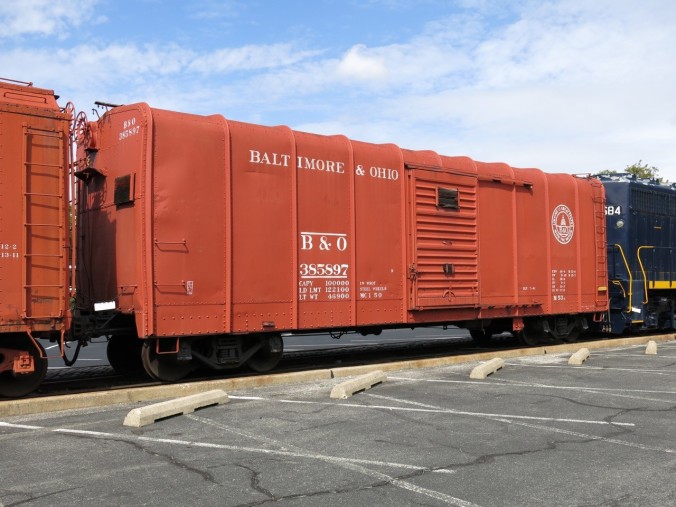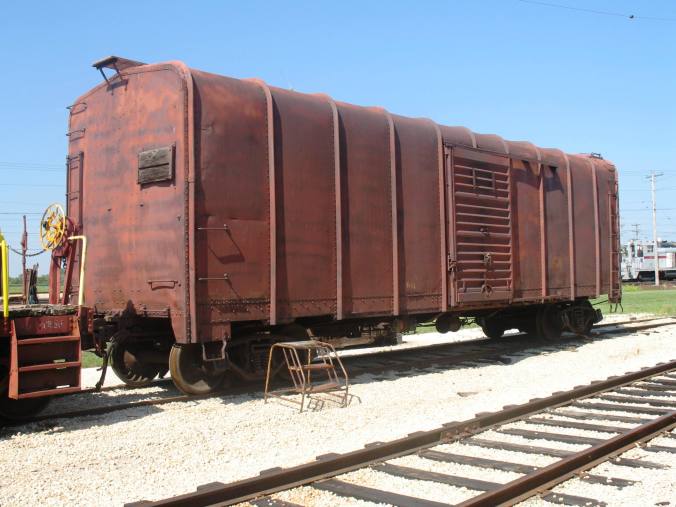Probably the most easily recognized box car on the US railroads in the 1950s was the B&O “wagon-top” box car. Here are a few detail photos of the well-preserved B&O M-53 wagon top car at the B&O Railroad Museum in Baltimore. I took these photos on a trip through the northeast US in September 2015.

B&O’s series of wagon top cars was very innovative for their time. The road first rebuilt almost 1,290 M-15 cars of various types to the wagon-top design beginning in 1936. Later, beginning in 1937, B&O built 2,000 all new cars, class M-53, from the ground up. Another 1,000 cars were built in 1953. The wagon top design featured a rounded roof designed to eliminate roof leaking—which was a constant problem with standard box cars of the era—and it worked. The M-53 also incorporated the Duryea cushioned underframe, which helped reduce damage to lading and may have contributed to increasing the fleet’s life span.
The data below describes the car in the museum collection, and is included from the B&O Museum website at http://www.borail.org/385897.aspx:
Name: B&O No.385897
Railroad of Record: Baltimore & Ohio Railroad
Type of Car: Wagon-Top boxcar, steel
Class: M-53A
Manufactured by: B&O Railroad
Date Built: 1941
Car Weight: 23.5 tons
Load Capacity: 50 tons
Inside length: 40.5 feet
Cubic Capacity: 3712 cu. feet
The No. 385897 was built by the Baltimore & Ohio Railroad in 1941. It was lightweight and could carry up to 50 tons. By the 1970s, the popular design was considered small and lacked proper protection for cargo. The No.385897 retired from service in 1981 and a year later was sent to the B&O Railroad Museum.




This car (below) is part of the collection at the Union Transportation Museum in Union, Illinois. I took this photo in 2004. This is a former M-15N that was originally built in 1925. When rebuilt the car received number 374065. You can tell the difference between the M-15 and M-53 by the lower side sill. The M-15 series has an indented bottom side sill; the M-53 side continues all the way to the bottom of the car.

There are many good models of the M-53 cars available in HO. For decades about the only way to acquire a car in HO was the Red Ball model, or one of the brass cars released by Overland or Precision Scale in the 1980s. West Shore Line offered a hard-to-get resin model. Then around 2005 a number of manufacturers scrambled to offer a car, including Wright-Trak and Sunshine Models, and later Fox Valley, Funaro and Camerlengo, ExactRail, and probably a few others joined the fray.
In my opinion the best HO model is the Exactrail offering although the Duryea underframe is not very well represented. The Sunshine car was a little difficult to build—now you can get them for a dime a dozen on eBay. In O Scale, Chooch produced a beautiful M-53 as part of it’s Ultra-Scale line. That car is out of production and very hard to find but it is gorgeous.
Below. He is a photo of my Exactrail M-53. I replaced the trucks with Intermountain ARA trucks with Reboxx 1.015-width wheelsets with semi-scale wheelsets, then sandblasted the car and repainted it with Scalecoat 2 Oxide Red. I used Ted Culotta’s the outstanding Speedwitch M-53 decal set for the model–which can be found at speedwitchmedia.com–and then sealed the decals with a 50-50 mix of testers Dullcoat and Glosscoat. It is supposed to represent a newly-repainted car so I gave it a light coating of dust and that was it.

Below. Here is another M-53 model. Naturally I bought this one before the flood of models came in HO in the mid-2000s. This is an older Precision Scale brass car with post-war doors. This is a nice model and like my Exactrail car I stripped it and repainted it with Scalecoat One Oxide Red. I used Speedwitch decals on this car as well. New parts include Kadee #58 couplers and Intermountain ARA trucks with reboxx 1.015-width 33-inch semi-scale wheelsets.


Above. the Duryea underframe on the Precision Scale car is rather poorly represented, but the overall the model captures the prototype well.
I hope you have enjoyed the photos!






























